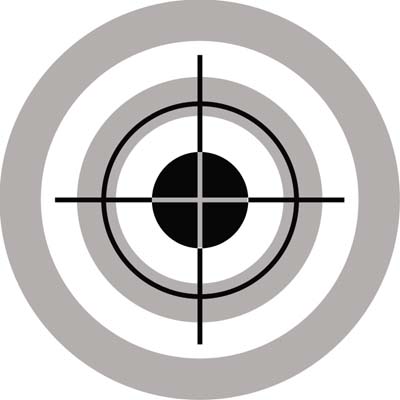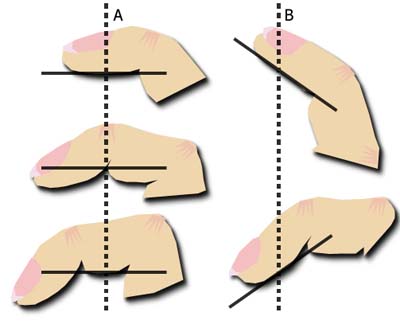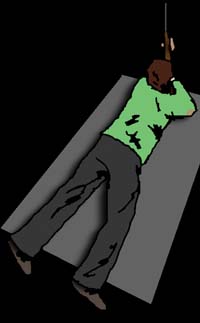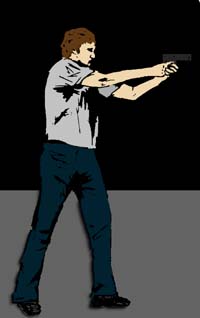Technique & Tips
Technique & Tips
This section aims to provide a general overview of the techniques used in shooting and to give some tips that might help in the sport.
Whatever type of shooting it is consistency that is the aim of the target shooter; to repeat a shot again and again in precisely the right way.
It is also important to note the problems that complacency can bring; if a shooter expects to do well because they previously got a perfect shot, they can lose concentration for their next attempt. This can also affect the shooter if they miss a shot - by dwelling on it they lose concentration. You must take each shot separately - if you did well previously, remember how you did it and do it again. If you did not hit the target as you had hoped, rethink, concentrate and try again.
Air pistol/Black powder pistol
Ensure that you know the zero setting of your rifle. It you do not know where it is shooting, you will waste much valuable range time and could be shooting out of the range's safe area.
Get to know your rifle - its abilities to hold patterns in different conditions/ammunition. You are striving for consistency and the key to this is to know your equipment. To become a capable shot is a combination of knowing your gun and its limitations along with personal skill.
Rifle fit is important - the length between the trigger and the butt of the stock - that is the 'length of pull' can be varied by adjusting the length of stock to fit the shooter.
Every time you fire the rifle shockwaves are sent through the gun and these affect the accuracy of the shot. As every rifle is different the shot affects the rifle differently resulting in varying accuracy for all rifles.
Using different bullets makes this problem more notable; even if cartridges are similar in weight or design, they are not identical; there are variations between manufacturers. They use different suppliers of cases, powders, primers etc.
As such, each variation of rifle and ammunition is individual.
When you find a consistent combination of ammunition to use with your rifle than works for you then stick with it! Hopefully the combination will stay accurate for some time. If not you should keep searching for that combination that works for you.
It is not however just the gun and ammunition that effect the consistency of shooting - the shooter himself is a big part of this. The idea of consistency should extend to the actions of the shooter himself taking into account hold, position and pressure.
A big problem with shooting is that of trigger control; remember to apply a steady consistent pressure until the trigger break. Gently squeeze the trigger - don’t pull or jerk it. A popularly taught concept is that the shooter should not anticipate the shot – it should come as a surprise when the trigger breaks. If a shooter however knows his gun he should know the stage at which the trigger will break, but the idea behind this teaching is the importance of concentrating on the sight picture rather than the act of squeezing the trigger.
There are four different types of trigger: the single stage, the two stage, the set trigger and the electric trigger. The two most common however are the single stage, which when pressure is applied fires the rifle without there being any take up, and the two stage (which is more common), where there is some movement when pressure is first applied (the take up) before a heavier pressure is felt which when pulled further fires the rifle.
Hold your breath for the instance whilst taking the shot - body movement while inhaling/exhaling can move the shot off target.
Follow through with your shot - do not drop your rifle as soon as you pull the trigger. Resist the urge to check your shot but keep it on target (this is particularly important for air rifles as the pellet does not travel the length of the barrel as fast as in a firearm), there is a risk that even the slightest movement can move your shot off of target, which may at short ranges be negligible - but is more pronounced over a long distance and in competition situations any loss is significant.
Do not hold your shot for too long if you have not fired within about 7 seconds of finding your position relax and do not take the shot. Lower the rifle and start again. If you hold the position too long you will lose the steadiness and concentration you need to take your shot.
Do not feel the need to shoot copious rounds of ammunition in one session, it is better to have fewer quality targets than many mediocre ones.
Buy the best rifle that you can afford and use quality ammunition with it. If you have a gun that is reliable then you can hone your skills knowing that it is you that is making the shots hit the target as they do - not an unreliable gun.
Aim for the 'X' ring (which is the broken-line ring at the centre of some targets - particularly in full-bore shooting); even though it often only scores the same as the bull in competition it is good practice to aim for the best possible score that you can.
Take note of the sight alignments below:
These should be noted for both rifle and pistol shooting using iron sights. If you align your sights so that they provide you with this sight pattern your shots should be centred on target.
If you are using a telescopic sight, you should set your sights up so that the cross hairs are centred on the target:
This is traditionally the backbone of rifle shooting in this country. Small-bore prone rifle is generally shot using iron sights, but if you are to shoot centre fire rifle from the prone position you may alternatively use telescopic sights. Small-bore prone rifle may be shot at 15, 20 or 25 yards indoors and 50 metres, 50 or 100 yards outside.
If shooting a prone rifle you should hold your breath on the exhale, as holding inhaled air can be uncomfortable especially when laying down wearing a fitted shooting jacket.
Hold the gun firmly against the shoulder; do not hug it too tightly. Recoil after the rifle has been fired moves the stock backwards, and, if your shoulder is tightly pressed against it, the recoil can not act backwards, and energy is expended in lifting the rifle. This is known as 'jump'. The jump can be decreased by the rifle expending greater amounts of recoil energy horizontally backwards, rather than vertically. If you hold the rifle in a more relaxed position, the gun is easier able to expend its recoil backwards.
As the trigger on small-bore target rifles are generally far lighter than those found on other rifles, and the 10 ring on the targets smaller, it is important to ensure the correct trigger pull; with your finger not correctly on the trigger you are likely to produce pulled shots. The correct finger position is one where the index finger is on the trigger on the first pad or up to the first joint, not beyond. You should be consistent with your finger position, or the shot will vary. It is only the index finger which moves when firing the shot, other hand movement can create inconsistency. Ensure that you do not move the rifle when pulling the trigger, only the trigger.
(A) shows an acceptable, straight pull
(B) shows a pull at an angle. Part of the pressure applied is wasted in pushing/pulling the rifle off target.
Your position whilst shooting a prone rifle is important, as there are many variables that can have an effect on your shot.
This position is recommended:
The body should be at an angle of approximately 20 degrees to the direction of shooting, in a natural position, with the spine and shoulders forming a 'T' shape. In a right handed shooter (as here) more weight lies on the left hand side which in turn makes it easier to breathe. By bending the right leg slightly pressure on the stomach can be relieved. The right inside knee should press on the mat as should the inside of your right foot.
The left elbow is forward, which will produce an extended, flat, stable position. The weight of the gun is supported by the left forearm. The right elbow should be forward and slightly to the right, this allows the shoulder to lie directly behind the rifle.
Here the shooter's head is at a natural angle (with not more than 5cm distance between the eye ands the rear sight) and the position forms a stable 'triangle'. The front of the stock rests on the ball of the thumb of the left hand. Fingers should be relaxed and not gripping or even touching the gun. The hand should be pushed right up to the sling buckle or the hand stop. By doing this the gun's stock will be securely held. The right hand must be holding the stock in a way that the trigger finger moves directly backwards. This ensures a steady pull, as previously mentioned. The right hand should not be exerting pressure on the gun. The trigger finger should not be in contact with the stock.
Ensure that the right shoulder position is not too high, as this can be uncomfortable in a prolonged shooting situation.
The rifle sling is an essential piece of equipment as without it the gun will only be supported by the strength of the shooter. The sling helps by forming a triangle between the forearm, stock and upper arm to provide stability.
The shooter must ensure that his pulse is not transmitted through the sling to the rifle; the effect of the pulse can make a notable difference to where the target is hit. The sling is usually worn above the upper arm muscle. With it below the muscle, the firing position is much lower (flatter) and you can run the risk of being penalised in competition situations if your position is below the allowed height.
When shooting in this position balance of the rifle is highly important. If a rifle has its centre of gravity (COG - i.e. the point at which it balances) near the front of the action the gun will handle smoothly. A rifle that balances forward of the action will hang on target better. To pick a compromise a rifle with its COG practically at the front of the action will have good handling characteristics along with steadiness on target.
The best way to stand when shooting in this position is with your body approximately at 45 degrees to the target. Your left foot and left shoulder should be forward of your body and your left foot pointing toward the target. Your foot position is important - do not have your feet too far apart, the heels should be about 30cm apart (the feet generally should be as far apart as the shoulders), assume a natural feeling position, lean back slightly and little to the right as this will help balance the rifle and give you a COG between the left leg and the centre of the body. The hip is thrust out when leaning the body back slightly, providing a support for the left elbow. The weight of the gun is supported by the left leg's bone structure. The amount that the hip is moved is dependant on the build of the shooter. It is important that the posture is comfortable and stable. Again, the backbone should form a 'T' with the shoulders; because of the slightly curved stance the spine is not completely straight.
With the butt of the gun in your right shoulder, you should position your left hand on the fore-end of the gun with your left elbow pointing downward, not out. Your right elbow should be pointing outwards, horizontal to the ground.
Head position and how you look through your scope (if you are using one) is also significant. You should bring the gun up to your eye level, (it does not matter if the rifle will be angled - as long as this is consistent) resting your cheek on the stock of the gun. If you are using a scope keep your eye in line with and about 3 or so inches behind the scope. Magnification more that 6x can hinder offhand shooting.
As earlier noted your breathing can make a difference to where your shot falls. If you are shooting standing it is recommended that your shot is taken in a pause on the inhaling breath as there is better support within the torso whilst breathing in.
Diagram shows shooter using a kneeling roll - an accessory which provides a stable position and helps stop the shooter's foot from going to sleep.
In a correctly balanced kneeling position the muzzle should be completely stable. Again, the backbone and shoulders form a 'T', though the backbone should be relaxed and not hunched, otherwise it will start to ache after prolonged shooting.
The shooter's chest should face towards the target; this allows a good shoulder contact and a steady position. The front foot should be facing at 45 degrees to the target, providing a stable leg position and will hopefully avoid wobbling. The left leg position should be vertical so as the left forearm and the leg between them take the weight of the rifle. To do this the left elbow should rest upon the knee. As with prone shooting the left hand should rest the fore-end upon the ball of the thumb, not grip it.
The right arm and shoulder should not be hunched, and as with the prone and standing shooting positions, the trigger should be pulled directly backwards. Again, the distance between eye and rear sight, as with prone rifle shooting, should be no more than 5cm.
The right leg position should form an angle of 90 degrees with the rifle, no more. The three supporting points - the left foot, the right knee and the right foot should be equally distant, forming a triangle. This will put the COG in the very middle. From looking at the diagram you can see that the thigh and forearm create a straight line.
As with standing rifle it is recommended that the shot is taken on the inhaling breath.
Many of the techniques used with small-bore shooting can be applied to using larger calibre rifles, although in 'F' class shooting - such as RTSC carry out at Bisley - there is the option to use a bipod to support the rifle rather than the sling. The position that the shooter adopts however is generally the same, he should still form a 'T' with his shoulders and backbone and to use the advice recommended for small-bore shooting will do no harm.
The effect of the wind on a shot particularly with full-bore outdoors shooting can be marked. The shooter needs to work out how much effect that the wind will have on his shot. He can do this by using the Beaufort Wind Scale, by looking at wind flags, which fly above the range, or by looking at the movement of the mirage when shooting on a hot day.
Beaufort Scale:
- Up to 3mph: Wind can barely be felt, but movement can be seen in smoke
- 4mph: Breeze can be felt on face
- 8 - 12mph: Leaves and small twigs in constant motion
- 16mph: Dust and paper begin to raise. Small branches begin to move
- 20mph: Smaller trees sway
Wind Flags:
 : Gentle wind, approximately 4mph.
: Gentle wind, approximately 4mph.
 : Moderate wind, approximately 8mph.
: Moderate wind, approximately 8mph.
 : Fresh wind, approximately 12mph.
: Fresh wind, approximately 12mph.
 : Strong wind, approximately 16mph.
: Strong wind, approximately 16mph.
 : Very strong wind, approximately 20mph.
: Very strong wind, approximately 20mph.
Also, see the slide show in Multimedia for the use of flags and the Beaufort Scale to estimate wind speed.
Mirage:
Mirage is experienced when light is refracted. This occurs when light passes through one medium to another. It can also occur when it passes through a different density of the same material. As such, passing through warm and cold air causes the light to bend. This means that the image seen is not where it actually is. If the air is still, this can be allowed for by clicking the sight settings over to compensate. However, this is highly unlikely to happen, and the streams of hot and cold air are continually moving.
The most likely time that mirage will be experienced is late-morning to mid-afternoon, on a hot sunny day, when the sun is at its highest point.
Mirage is not only connected with air drift caused by wind, but by hot air rising from heated ground and being replaced by cold air from above.
Horizontal mirage is caused by wind drift and appears as waves passing across the target.
Vertical mirage appears as rising, shimmering waves. Horizontal mirage appears as waves passing the target, bearing a close relationship to the wind that forms it.
The wind nearest to mid-range has the greatest effect on the bullet, as such it is prudent to try to work out the wind speed at this point, mirage should be noted at this point.
Scope pictures of mirage:
 Boiling/Vertical mirage
Boiling/Vertical mirage
 3 - 5 mph wind, negligible to gentle wind
3 - 5 mph wind, negligible to gentle wind
 5 - 8 mph wind, gentle to moderate wind
5 - 8 mph wind, gentle to moderate wind
 8 - 12mph fresh wind
8 - 12mph fresh wind
Mirage is unlikely to occur at higher speed winds due to the cooling effects of the breeze.
Air pistol/Black powder pistol:
Both these disciplines use similar techniques of holding the gun and body position, and, as such they will be addressed together.
As with other ammunition, quality can be variable between the premium grade air gun pellets, and the cheaper ranges available. For air pistol however the target is generally shot at 10 metres in competition and the 10 ring sufficiently big enough that the larger grouping of pellets will be less noticeable than with air rifle targets at the same range, where the centre ring is far smaller.
If you are shooting with one hand, adopt a similar stance to that taken in the standing position for rifle shooting, however reverse this. The feet should be about shoulder's width apart, the body facing approximately 45 degrees to the firing line, with the right foot pointing forward to the target. The head must be upright and erect and the free hand - that is the one not being used to pull the trigger, must not be allowed to move, as this will interfere with balance and throw the shot off target, a commonly popular stance has the free hand on the rear hip.
In two handed shooting, an often used stance has the left foot pointing in the direction of the target; the right foot is to the rear, slightly further apart than the width of the shoulder. This is demonstrated in the diagram below. This position is referred to as the Weaver Stance, after an American Deputy Sheriff.
The fingers of the weak hand encircle the shooting hand, which provides extra support and stability, without affecting the trigger pull.
Concentrate on the target to get an idea of its position, bring the pistol up, and then focus on the fore-sight, aligning it as previously shown.
As with standing rifle shooting, the shot should be fired when you have inhaled and pause your breathing, this chest movement adds stability to your hold.
Correct shotgun fitting is important; if a gun is too long/short in the stock it will not be easy to mount and shoot fluidly. A gun should be fitted so that it shoots where you look.
Your feet should be positioned as with an imaginary line extending from your rear heel to your leading foot which points to where you want to break the target. A fairly narrow stance will help you to swing smoothly.
There are two common techniques taught when shooting a shotgun, that of 'sustained lead' and 'swing-through'.
Sustained lead requires you to gauge the appropriate lead in front of the target, maintain this and shoot so that the bird flies into your pattern.
However it can take time to judge the speed of the bird and the lead necessary - so is not always practical for birds that are not in view for long.
The swing-through method has the shooter starting behind the bird, swinging through it and pulling the trigger once the bird has been overtaking and carrying the shot pattern ahead of the target. This also has its disadvantages as you do not always have the time to swing ahead of the bird far enough to establish the needed lead before it flies out of range.
If you can learn to mount the gun after starting to swing, it makes the process more fluid to starting shooting 'gun down'. As you start the swing rely on your reactions, as your eyes focus on the target finish the mount and take your shot.
Note that you should focus on the target, not on the gun barrel/bead. You can not easily take aim with a shotgun; if you do aim it can slow your swing and will end up with you shooting behind the bird. It is better to point towards the target - remember, the shot does not come out in one lump but a long string, so when aiming ahead of the bird the pattern of the shot should meet with the clay.
If you miss the bird it is most likely that you are shooting behind it, so you should try increasing your lead.
If you are shooting simultaneous pairs of birds, you should judge before you call for them which one you plan to shoot first. Unless the other bird is out of sight first or far more difficult it is usually suggested that you shoot the lower or rear clay first. In the case of shooting the lower bird first the gun recoil upon your shot should bring you nearer to the flight line of the upper bird. By shooting the rear clay first you continue your swing through and onto the second clay.
If you are new to shooting, it is important to practice. It is only by regularly experiencing shooting different clays that you can learn to judge the lead that you need to hit the target. It can also be helpful to get professional coaching to ensure that you do not pick up hard-to-shake bad habits.
Recommended reading and the source for some of the information provided on this page.
The Book of Shooting for Sport and Skill, Frederick Muller Ltd, Trewin Copplestone Publishing Ltd, London, 1980
Small-Bore Target Shooting, WH Fuller, Barrie & Jenkins Ltd, London, 1978 Edition
Rifle Shooting as a Sport - Basic Principles, Positions and Techniques, Bernd Klinger, Kaye & Ward Ltd, London, 1980


















